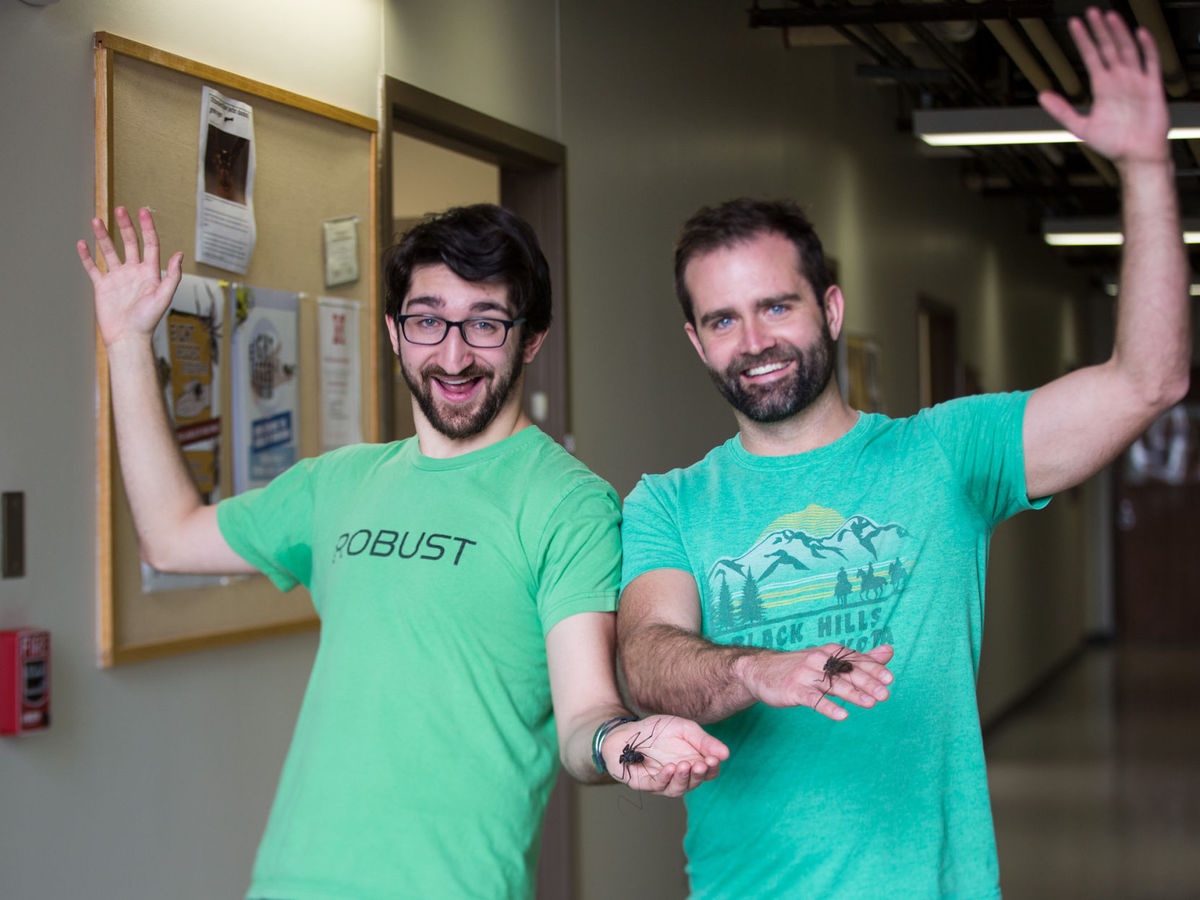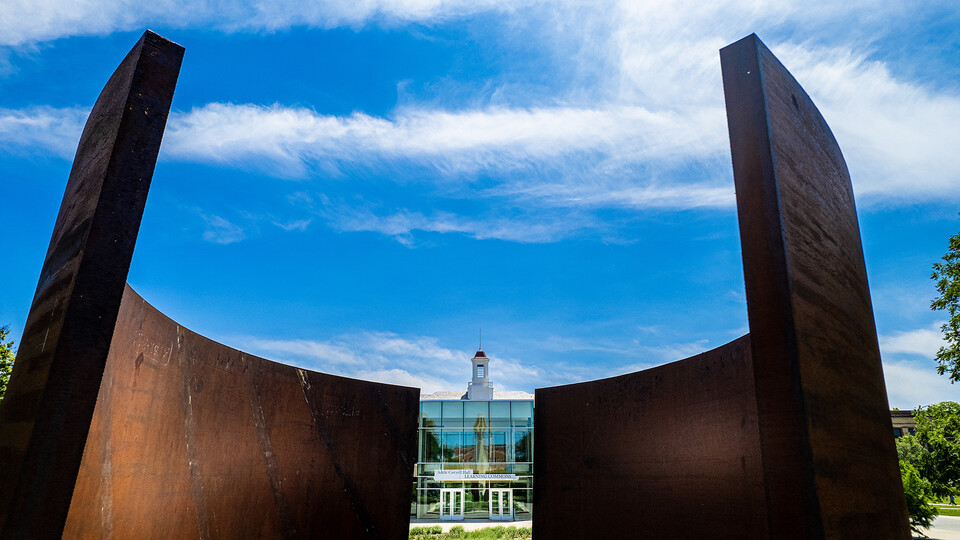
“I’m not a spider, but I’m still a cool arachnid.”
Combining their talents for science and media, two University of Nebraska-Lincoln biology students created a fun, informative music video that establishes just what an amblypygid really is, and why you should be interested. Matt Wilkins, a third-year post-doctoral student, and Tyler Corey, a graduate student studying for a Ph.D, used music, film and research to creatively educate viewers on an ancient arachnid that is not, in fact, a spider.
Corey and Wilkins will show their video “Pygids,” along with other video entries from the Evolution Film Festival, at Morrill Hall Feb. 12. Corey and Wilkins will also host a discussion about their video and research, and will bring along some of their arachnid friends to show.
“Of all of the cool and interesting papers on the amblypygi, and there really are not many, Professor Hebets was the author on most of them,” Corey said. “It happened to be around the time I was applying to graduate schools, and I knew I wanted to work with animal behavior, so I reached out to Hebets. Pygids brought me here to UNL and they keep me coming and going quite often.”
Wilkins met Corey when they both moved to Lincoln around the same time. Corey began his work for graduate school while Wilkins began his post-doctoral degree, which continued the studies from his Ph.D. research on sexual selection and resulting speciation in various bird species.
“I studied barn swallows all across the northern hemisphere, with a broad interest in how song and visual ornaments relate to each other in mate choice versus competition,” Wilkins said. “I’ve found it’s much easier to study this stuff in arachnids than in barn swallows. There’s way less paperwork, and people usually say to just take them.”
The two became friends not from a respect for biology, nor from a mutual love of amblypygids, but from a shared interest in comedy. Corey said once the word was spread that both biologists were fans of comedy and stand-up, it was only a matter of time. The friendship blossomed from there, building from their interests in comedy and biology.
The pair’s research and pursuits brought them together within the heart of Costa Rica. Corey was conducting arachnid research in affiliation with the Organization for Tropical Studies, which he describes as an “international consortium of universities that supports research in the tropics for students.”
Wilkins, on the other hand, found himself in search of a way to engage the public with biology through the use of different media. Writing, photography and film were some of the tools at Wilkins’ disposal when he arrived in Costa Rica for a class on scientific journalism. When the two discovered they were both going to be in the equatorial country at the same time, they came up with a way to fuse their projects of amblypygi research and media outreach to create an informative, engaging piece of media about the arachnid.
With Corey’s expertise on the animal of interest and Wilkin’s knowledge of film and direction, they set off on a 36-hour documentary journey into the jungle. They captured majestic sunrise and sunset shots, beautiful snapshots and sounds of the lively jungle, and, of course, up close and personal footage of the amblypygid in its natural habitat.
This arachnid is nocturnal, so it could only be filmed fighting, feeding and mating when the sun went down. Corey’s process of research had him find different amblypygi, mark them and return the following night to see where they ended up and what they were up to.
“It was great timing, as I had some amblypygi already marked and knew where enough were where we could get good footage of me actually catching one as opposed to me missing them,” Corey said.
After filming, Wilkins and Corey said they didn’t have a clear vision of what to do with the abundance of film they had gathered over the last day and a half. They both agreed that comedy and humor would be incorporated into the final edit, but could feel the project needed another facet to truly come to life.
“I had this weird bossa nova baseline that I liked and thought was charming, and I wanted to turn it into a song of some kind,” Corey said. “It hit me, ‘Oh, this would be fun if I could create a song about amblypygids with this baseline.’ I wrote and sang the song for a project in one of my classes, and Matt came up to me afterwards and said, ‘Dude, that’s our video.’”
The song was condensed and added to the video alongside humorous, informative narration about the arachnid. The end product presented itself as a three minute long educational music video titled, “Pygids.” The completion of their passion project, however, was only the beginning.
This past summer was the Sixth Annual Evolution Conference and Film Festival. Wilkins and Corey submitted their music video into the competition where different short films were judged based on how well they conveyed scientific subjects to the general public.
To Corey and Wilkin’s joy, “Pygids” was incredibly well-received, winning first place at the Evolution Film Festival competition. The blend of humor, music and biology with a clear, educational direction won over the judges and netted the pair a trophy with Charles Darwin’s head on top. Wilkins said it was definitely an emotional experience to see his video receive so much praise.
“I was getting pretty emotional about it,” Wilkins said. “We spent months working on this, going back and forth, for a three minute video. You look back and say, ‘This is pretty silly,’ but I’m proud of it.”
With “Pygids” completed and under their belts, Wilkins and Corey still search for ways to blend artistic pursuits with their biological studies. Wilkins says he’ll continue to pursue research along with creative ways to educate the public through different areas of media. Corey has a specific project in mind, saying he is interested in finding or creating an 80s style workout anthem to pair with an exercise routine that mimics the different behaviors of the amblypygi, again pairing his passion for music, humor and biology to create another unique project.
To Corey and Wilkins, finding projects like “Pygids” that successfully and creatively combine artistic interests with biology make science that much more exciting.


